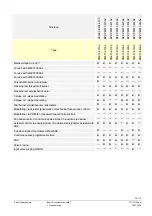
10/116
Smart Infrastructure
Basic Documentation LME7...
CC1P7105enr
1 Safety notes
24.07.2020
1.3 Installation
notes
Always run the high-voltage ignition cable separate from the unit and other cables
while observing the greatest possible distance
Do not mix up live and neutral conductors
Install switches, fuses and earthing in compliance with local regulations
Risk of damage to the switching contacts!
If the external primary fuse (Si) is blown due to overload or short-circuit at the
terminals, the LME7 must be replaced.
The connection diagrams show the LME7 with an earthed neutral conductor. When
monitoring ionization currents in earth-free mains, connect terminal X10-05 pin 1 to
burner ground. It is essential to ensure that local regulations are complied with (e.g.,
protection against electric shock) since 230 V AC (50/60 Hz) mains voltage
produces a leakage current of 2.7 mA
Make certain that the maximum permissible current rating of the connection
terminals is not exceeded
Make certain that strain relief of the connected cables is in compliance with the
relevant standards
Do not feed external (mains) voltage to the control outputs of the LME7. When
checking the functions of the components controlled by the LME7 (fuel valves or
similar), the LME7 may, in principle, be connected to the components
Mains power must always be supplied via L and N. This means that no potential
differential must exist between the neutral conductor N and protective earth PE
Make certain that strain relief of the connected cables is in compliance with the
relevant standards (e.g. as per DIN EN 60730 and DIN EN 60335)
Ensure that spliced wires cannot get into contact with neighboring terminals. Use
adequate ferrules. If this is not observed, there is a risk of loss of safety functions or
a risk of electric shock
For protection, the burner manufacturer must fit dummy plugs to unused LME7
terminals
The connectors of the connecting cables for the LME7, may only be removed or
exchanged when the plant is shut down (all-polar disconnection), since the
connections (especially BCI interface) does not provide safe separation from mains
voltage
The mechanical coupling between the actuators and the controlling elements for
fuel and air, or any other controlling elements, must be rigid
Signal cable AGV50 from LME7 to AZL2 or from LME7 to OCI410:
Since the BCI has no safe separation from mains voltage, the signal cable AGV50
between LME7 and AZL2, or LME7 and OCI410, must conform to certain
specifications. Siemens has specified the signal cable AGV50 for use under the
burner hood (see Technical data). When using signal cables of other manufacture,
Siemens’ requirement will not necessarily be met
Do not lay the signal cable AGV50 from the LME7 to the AZL2 together with other
cables; use a separate cable
Service operation with a longer signal cable from LME7 to AZL2, or from LME7 to
OCI410:
If a longer signal cable is required for service work for example (short-time,
<24 hours), note that above usage under the burner hood no longer applies and, for
this reason, the signal cable can be subjected to increased mechanical stress. In
that case, extra cable sheathing is required
Both the signal cable AGV50 and the AZL2 must be shipped and stored so that no
damage due to dust and water can occur when used in the plant later on
The AZL2 must be used in a dry and clean environment
Check the connecting lines of the air pressure switch for short-circuits











































